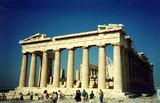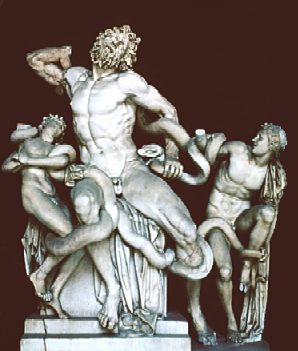The sculpture and architecture of the Greek civilization provides a dazzling demonstration of the Greek artisans who strove for visual perfection.
 The Parthenon on the Acropolis was built to pay tribute to the goddess Athena. The lines of the building were deliberated designed to allow the viewer to see it in it's purest form.
The Parthenon on the Acropolis was built to pay tribute to the goddess Athena. The lines of the building were deliberated designed to allow the viewer to see it in it's purest form.
For example the fluting or grooves on the Ionic and Corinthian columns were inscribed into these support structures so the roundness of the columns would be revealed through the shadows created by the sunlight shining on them.
The statues created had a remarkable naturalistic quality which was motivated by their knowledge and interest of human anatomy.
quality which was motivated by their knowledge and interest of human anatomy.
The Greek sculptor Praxilites embodied this philosophy in the La÷coon Group.
Gothic Cathedrals gave glory to the god with their spires and vaulted archways pointing to the heavens.
The medieval artist painted iconographic, stylized depictions which were used to adorn the chapels and churches of the Medieval monasteries. Religious themes were prevalent. All paintings had a flat gold background.
Giotto broke this tradition by showing roundness in his shaded figures. Although the proportions of the baby looks like a little man. Giotto, the "Father of painting" was motivated by the natural world. The background in his painting shows a spatial awareness.
Out of the darkness of the Medieval Ages appears a new way of thinking about art.
Leonardo da Vinci developed a system of linear perspective to construct depth into a painting. He also developed aerial perspective in paintings to show distance with mist and muted colors.
Da Vinci designed 'Colossus' a horse, the size of a house in the tradition of the Egyptian monumental statues.

- Leonardo's dreams were dashed when the bronze needed for the project was reallocated for cannons used in the war effort.
- His dreams were shattered when the archers used his clay model for target practice.
- His horse was unveiled in Milan on September 10, 1999 through the untiring efforts of Charles Dent to make Leonardo da Vinci's dream into a reality with the assistance of Japanese sculptress Nina Akuma who helped complete the project.
The original Mona Lisa painting that is hanging in the Louvre had Greek columns on the sides of the painting. Leonardo often brought elements of the past into his work.
The original Mona Lisa painting was reduced in size to fit the frame.
These columns were removed so the painting could fit into the frame at the museum.